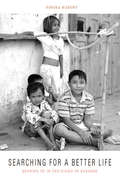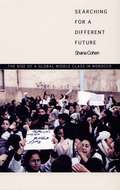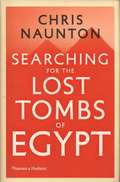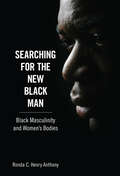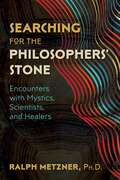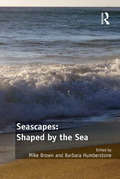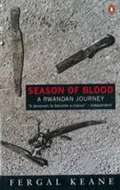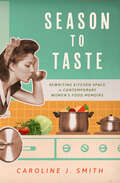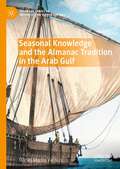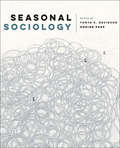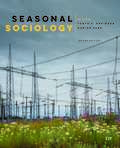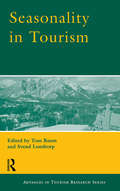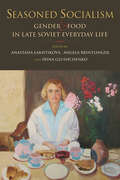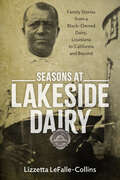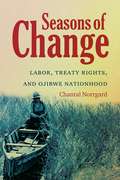- Table View
- List View
Searching for Whitopia: An Improbable Journey to the Heart of White America
by Rich BenjaminAs America becomes more and more racially diverse, Rich Benjamin noticed a phenomenon: Some communities were actually getting less multicultural. So he got out a map, found the whitest towns in the USA--and moved in.A journalist-adventurer, Benjamin packed his bags and embarked on a 26,909-mile journey throughout the heart of white America, to some of the fastest-growing and whitest locales in our nation. Benjamin calls these enclaves "Whitopias." In this groundbreaking book, he shares what he learned as a black man in Whitopia. Benjamin's journey to unlock the mysteries of Whitopia took him from a three-day white separatist retreat with links to Aryan Nations in North Idaho to exurban mega-churches down South, and many points in between. A compelling raconteur, bon vivant, and scholar, Benjamin reveals what Whitopias are like and explores the urgent social and political implications of this startling phenomenon. Benjamin's groundbreaking study is one of few to have illuminated in advance the social and political forces propelling the rise of Donald Trump. After all, Trump carried 94 percent of America's Whitopian counties. And he won a median 67 percent of the vote in Whitopia compared to 46 percent of the vote nationwide.Leaving behind speculation or sensationalism, Benjamin explores the future of whiteness and race in an increasingly multicultural nation.
Searching for Yellowstone: Race, Gender, Family and Memory in the Postmodern West
by Norman K DenzinYellowstone. Sacagawea. Lewis & Clark. Transcontinental railroad. Indians as college mascots. All are iconic figures, symbols of the West in the Anglo-American imagination. Well-known cultural critic Norman Denzin interrogates each of these icons for their cultural meaning in this finely woven work. Part autoethnography, part historical narrative, part art criticism, part cultural theory, Denzin creates a postmodern bricolage of images, staged dramas, quotations, reminiscences and stories that strike to the essence of the American dream and the shattered dreams of the peoples it subjugated.
Searching for Zion: The Quest for Home in the African Diaspora
by Emily RaboteauFrom Jerusalem to Ghana to Katrina-ravaged New Orleans, a woman reclaims her history in a &“beautifully written and thought-provoking&” memoir (Dave Eggers, author of A Hologram for the King and Zeitoun). A biracial woman from a country still divided along racial lines, Emily Raboteau never felt at home in America. As the daughter of an African American religious historian, she understood the Promised Land as the spiritual realm black people yearned for. But while visiting Israel, the Jewish Zion, she was surprised to discover black Jews. More surprising was the story of how they got there. Inspired by their exodus, her question for them is the same one she keeps asking herself: have you found the home you&’re looking for? In this American Book Award–winning inquiry into contemporary and historical ethnic displacement, Raboteau embarked on a ten-year journey around the globe and back in time to explore the complex and contradictory perspectives of black Zionists. She talked to Rastafarians and African Hebrew Israelites, Evangelicals and Ethiopian Jews—all in search of territory that is hard to define and harder to inhabit. Uniting memoir with cultural investigation, Raboteau overturns our ideas of place, patriotism, dispossession, citizenship, and country in &“an exceptionally beautiful . . . book about a search for the kind of home for which there is no straight route, the kind of home in which the journey itself is as revelatory as the destination&” (Edwidge Danticat, author of The Farming of Bones).
Searching for a Better Life: Growing Up in the Slums of Bangkok
by Sorcha MahonyLife in Bangkok for young people is marked by profound, interlocking changes and transitions. This book offers an ethnographic account of growing up in the city’s slums, struggling to get by in a rapidly developing and globalizing economy and trying to fulfil one’s dreams. At the same time, it reflects on the issue of agency, exploring its negative potential when exercised by young people living under severe structural constraint. It offers an antidote to neoliberal ideas around personal responsibility, and the assumed potential for individuals to break through structures of constraint in any sustained way.
Searching for a Different Future: The Rise of a Global Middle Class In Morocco
by Shana CohenBy examining how neoliberal economic reform policies have affected educated young adults in contemporary Morocco, Searching for a Different Future posits a new socioeconomic formation: the global middle class. During Morocco's postcolonial period, from the 1950s through the 1970s, development policy and nationalist ideology supported the formation of a middle class based on the pursuit of education, employment, and material security. Neoliberal reforms adopted by Morocco since the early 1980s have significantly eroded the capacity of the state to nurture the middle class, and unemployment and temporary employment among educated adults has grown. There is no longer an obvious correlation between the best interests of the state and those of the middle-class worker. As Shana Cohen demonstrates, educated young adults in Morocco do not look toward the state for economic security and fulfillment but toward the diffuse, amorphous global market. Cohen delves into the rupture that has occurred between the middle class, the individual, and the nation in Morocco and elsewhere around the world. Combining institutional economic analysis with cultural theory and ethnographic observation including interviews with seventy young adults in Casablanca and Rabat, she reveals how young, urban, educated Moroccans conceive of their material, social, and political conditions. She finds that, for the most part, they perceive improvement in their economic and social welfare apart from the types of civic participation commonly connected with nationalism and national identity. In answering classic sociological questions about how the evolution of capitalism influences identity, Cohen sheds new light on the measurable social and economic consequences of globalization and on its less tangible effects on individuals' perception of their place in society and prospects in life.
Searching for the Bright Path: The Mississippi Choctaws from Prehistory to Removal
by James Taylor CarsonBlending an engaging narrative style with broader theoretical considerations, James Taylor Carson offers the most complete history to date of the Mississippi Choctaws. Tracing the Choctaws from their origins in the Mississippian cultures of late prehistory to the early nineteenth century, Carson shows how the Choctaws struggled to adapt to life in a New World altered radically by contact while retaining their sense of identity and place. Despite changes in subsistence practices and material culture, the Choctaws made every effort to retain certain core cultural beliefs and sensibilities, a strategy they conceived of as following “the straight bright path.” This work also makes a significant theoretical contribution to ethnohistory as Carson confronts common problems in the historical analysis of Native peoples.
Searching for the Just City: Debates in Urban Theory and Practice (Questioning Cities)
by Peter Marcuse Johannes Novy James Connolly Ingrid Olivo Cuz Potter Justin SteilCities are many things. Among their least appealing aspects, cities are frequently characterized by concentrations of insecurity and exploitation. Cities have also long represented promises of opportunity and liberation. Public decision-making in contemporary cities is full of conflict, and principles of justice are rarely the explicit basis for the resolution of disputes. If today’s cities are full of injustices and unrealized promises, how would a Just City function? Is a Just City merely a utopia, or does it have practical relevance? This book engages with the growing debate around these questions. The notion of the Just City emerges from philosophical discussions about what justice is combined with the intellectual history of utopias and ideal cities. The contributors to this volume, including Susan Fainstein, David Harvey and Margit Mayer articulate a conception of the Just City and then examine it from differing angles, ranging from Marxist thought to communicative theory. The arguments both develop the concept of a Just City and question it, as well as suggesting alternatives for future expansion. Explorations of the concept in practice include case studies primarily from U.S. cities, but also from Europe, the Middle East and Latin America. The authors find that a forthright call for justice in all aspects of city life, putting the question of what a Just City should be on the agenda of urban reform, can be a practical approach to solving questions of urban policy. This synthesis is provocative in a globalised world and the contributing authors bridge the gap between theoretical conceptualizations of urban justice and the reality of planning and building cities. The notion of the Just City is an empowering framework for contemporary urban actors to improve the quality of urban life and Searching for the Just City is a seminal read for practitioners, professionals, students, researchers and anyone interested in what urban futures should aim to achieve.
Searching for the Lost Tombs of Egypt
by Chris NauntonArcheologist Chris Naunton examines the famous pharaohs, their achievements, the bling they might have been buried with, the circumstances in which they were buried, and why those circumstances may have prevented archeologists from finding these tombs.
Searching for the New Black Man: Black Masculinity and Women's Bodies (Margaret Walker Alexander Series in African American Studies)
by Ronda C. AnthonyUsing the slave narratives of Henry Bibb and Frederick Douglass, as well as the work of W. E. B. Du Bois, James Baldwin, Walter Mosley, and Barack Obama, Ronda C. Henry Anthony examines how women's bodies are used in African American literature to fund the production of black masculine ideality and power. In tracing representations of ideal black masculinities and femininities, the author shows how black men's struggles for gendered agency are inextricably entwined with their complicated relation to white men and normative masculinity. The historical context in which this study couches these struggles highlights the extent to which shifting socioeconomic circumstances dictate the ideological, cultural, and emotional terms upon which black men conceptualize identity.Yet, Anthony quickly moves to texts that challenge traditional constructions of black masculinity. In these texts she traces how the emergence of collaboratively gendered discourses, or a blending of black female/male feminist consciousnesses, are reshaping black masculinities, femininities, and intraracial relations for a new century.
Searching for the Philosophers' Stone: Encounters with Mystics, Scientists, and Healers
by Ralph MetznerA deeply personal account of the scientific, shamanic, and metaphysical encounters that led to the development of Metzner’s psychological methods • Recounts the author’s meetings and friendships with Albert Hofmann, Alexander Shulgin, the McKenna brothers, Wilson Van Dusen, Myron Stolaroff, and Leo Zeff • Details his lucid dream encounters with G. I. Gurdjieff, profoundly healing sessions with Hawaiian healer Morrnah Simeona, experiences with plant teachers iboga and ayahuasca, and ecological and mystical lessons learned from animal teachers • Shares his involvement in the beginnings of the therapeutic use of MDMA and how it safely and effectively supports the healing of trauma, PTSD, and interpersonal relationships Just as the search for the philosopher’s stone is the core symbol of the alchemical tradition, Ralph Metzner, Ph.D., psychotherapist and one of the respected elders of the psychedelic research community, sees it as the central metaphor of his life-long quest to find methods of healing and insight through heightened states of consciousness. Through captivating stories Metzner shares his encounters from the 1960s through the 1990s with genius scientists, shamanic healers, mystics, plant spirits, and animal guides that led to the development of his “alchemical divination” psychological methods, a structured intuitive process of accessing inner sources of healing and insight. He details lessons learned with psychedelic research legends Albert Hofmann, Alexander Shulgin, Terence McKenna, and Dennis McKenna. He reveals his deeply healing encounters with the Kahuna bodywork healer Morrnah Simeona, the first to introduce the Hawaiian Ho’oponopono healing method to the West, and his experiences with West African trance dancing and the psychoactive plant-drug iboga. Metzner recounts in vivid detail his unwelcome encounter with malignant sorcery during an ayahuasca experience in Ecuador and the lessons it taught him about connections with spirits, both harmful and beneficial. He tells of his involvement in the beginnings of the therapeutic use of MDMA and shows how it is an effective and safe substance to support psychotherapy for healing trauma, PTSD, and interpersonal relationships. In sharing his remarkable encounters, Metzner shows how the most meaningful lessons in the alchemy of life come not only from the geniuses we meet but also from the spirits we encounter along the way.
Seascapes: Shaped By The Sea
by Mike Brown Barbara HumberstoneDespite the fact that the sea covers 70 per cent of the Earth’s surface, and is integral to the workings of the world, it has been largely neglected or perceived as marginal in modern consciousness. This edited collection disrupts notions of the sea as ’other’, as foreign and featureless, through specific, situated accounts which highlight the centrality of the sea for the individuals concerned. Bringing together academics who combine scholarly expertise with lived experiences on, in and with the sea, it examines humans’ relationships with the sea. Through the use of auto-ethnographic accounting, the contributors reflect on how the sea has shaped their sense of identity, belonging and connection. They examine what it is to be engaged with the sea, and narrate their lived, sentient, corporeal experiences. The sea is a cultural seascape just as it is physical reality. The sea shapes us and we, in turn, attempt to ’shape it’ as we construct various versions of it that reflect our on-going and mutable relationship with it. The use of embodied accounts, as a way of conveying lived-experiences, and the integration of relevant theoretical frames for understanding the broader cultural implications provide new opportunities to understand seascapes.
Season Ticket: A Baseball Companion
by Roger AngellAngell&’s absorbing collection traces the highs and lows of major-league baseball in the 1980s Roger Angell once again journeys through five seasons of America&’s national pastime—chronicling the larger-than-life narratives and on-field intricacies of baseball from 1982 to 1987. Angell&’s collected New Yorker essays, written in his unique voice as a fan and baseball aficionado, cover the development of the game both on the diamond and off. While diving into subjects such as Sparky Anderson&’s &’84 Detroit Tigers, the legendary 1986 World Series and the Curse of the Bambino, and the increasingly pervasive issue of player drug use, Angell reveals the craft and technique of the game, and the unforgettable stories of those who played it.
Season of Blood: A Rwandan Journey
by Fergal KeaneIn his powerful account of the Rwandan genocide, Fergal Keane rejects the widely held perception that the slaughter was the simple consequence of tribal antagonisms, and instead blames unscrupulous politicians for fomenting ethnic rivalry.
Season of Death: A Memoir
by Mark Raphael BakerMark Raphael Baker was no stranger to death. Over seven years he had become a mourner three times over: for his first wife, for his brother and for his father. When diagnosed with pancreatic cancer, he began to reflect on their deaths, his probable death and on Death as, in the words of Ecclesiastes, a 'season' that produced a large and bitter harvest for the Baker family. Powerful and conflicting emotions assailed him, but their destructive power was always defeated by his love of his family and of life, which never deserted him even when his spirit was most weary. Over the short course of his illness, he came to realise that to love both truly, he must die as the most authentic version of himself he can achieve. It enabled him to die with humbling grace and dignity. In A Season of Death, readers of The Fiftieth Gate and Thirty Days will rediscover the many forms of Mark's humour, his candour and his depth of thought and feeling, albeit in a different key, as it must be when those virtues reveal themselves in expressions of vulnerability that fend off self-pity. There is profound sorrow in this memoir but there is matching joy and much love, interwoven by a fine writer and thinker into a story that will deepen one's understanding of life.
Season of Madness
by Robert ScottCalifornia Nightmare. . .Annette Edwards was a vivacious 19-year-old on her way to watch the Fourth of July fireworks. Eighteen-year-old Pam Moore was a former beauty pageant contestant, hitching a ride on a busy street. Linda Slavik was a young mother enjoying a night out with a friend. Annette Selix was just eleven, an innocent child on her way home from the market. Each of them was attacked without warning, brutally assaulted, and left for dead by a bitter, disfigured man in the grip of a violent frenzy: the so-called "Hilltop Rapist." But serial predator Darrell Rich didn't stop at just four victims. He couldn't stop. . ."Scott tells a true story with compassion and taste." --Reviewing the EvidencePraise for Robert Scott and Shattered Innocence"Compelling and shocking. . .a ground-breaking book." --Robert K. Tanenbaum "Fascinating and fresh. . .a fast-paced, informative read." --Sue Russell
Season of the Witch: Enchantment, Terror and Deliverance in the City of Love
by David TalbotThe critically acclaimed, San Francisco Chronicle bestseller—a gripping story of the strife and tragedy that led to San Francisco&’s ultimate rebirth and triumph.Salon founder David Talbot chronicles the cultural history of San Francisco and from the late 1960s to the early 1980s when figures such as Harvey Milk, Janis Joplin, Jim Jones, and Bill Walsh helped usher from backwater city to thriving metropolis.
Season to Taste: Rewriting Kitchen Space in Contemporary Women’s Food Memoirs (Ingrid G. Houck Series in Food and Foodways)
by Caroline J. SmithBetween 2000 and 2010, many contemporary US-American women writers were returning to the private space of the kitchen, writing about their experiences in that space and then publishing their memoirs for the larger public to consume. Season to Taste: Rewriting Kitchen Space in Contemporary Women’s Food Memoirs explores women’s food memoirs with recipes in order to consider the ways in which these women are rewriting this kitchen space and renegotiating their relationships with food.Caroline J. Smith begins the book with a historical overview of how the space of the kitchen, and the expectations of women associated with it, have shifted considerably since the 1960s. Better Homes and Gardens, as well as the discourse of the second-wave feminist movement, tended to depict the space as a place of imprisonment. The contemporary popular writers examined in Season to Taste, such as Ruth Reichl, Kim Sunée, Jocelyn Delk Adams, Julie Powell, and Molly Wizenberg, respond to this characterization by instead presenting the kitchen as a place of transformation. In their memoirs and recipes, these authors reinterpret their roles within the private sphere of the home as well as the public sphere of the world of publishing (whether print or digital publication). The authors examined here explode the divide of private/feminine and public/masculine in both content and form and complicate the genres of recipe writing, diary writing, and memoir. These women writers, through the act of preparing and consuming food, encourage readers to reconsider the changing gender politics of the kitchen.
Seasonal Knowledge and the Almanac Tradition in the Arab Gulf (Palgrave Series in Indian Ocean World Studies)
by Daniel Martin VariscoThis book is the first in English to survey indigenous knowledge of seasonal, astronomical, and agricultural information in Arab Gulf almanacs. It provides an extensive analysis of the traditional information available, based on local almanacs, Arabic texts and poetry by Gulf individuals, ethnographic interviews, and online forums. A major feature of the book is tracing the history of terms and concepts in the local seasonal knowledge of the Gulf, including an important genre about weather stars, stemming back to the ninth century CE. Also covered are pearl diving, fishing, seafaring, and pastoral activities. This book will be of interest to scholars who study the entire Arab region, since much of the lore was shared and continues through the present. It will also be of value to scholars who work on the Indian Ocean and Red Sea Trade Network, as well as the history of folk astronomy in the Arab World.
Seasonal Sociology
by Tonya K. Davidson Ondine ParkLife in Canada is marked, celebrated, enjoyed, and dreaded in ways that respond specifically to the seasons. Sociological thinking allows people to ask questions about things that may otherwise be taken for granted. Thinking about the seasons sociologically opens up a unique perspective for studying and understanding social life. Each chapter in this collection approaches the seasons and the passage of time as a way to explore issues of sociological interest. The authors use seasonality as a device that can bridge, in fascinating ways, small-scale interpersonal interactions and large formal institutional structures. These contemporary, Canadian case studies are wide-ranging and include analyses of pumpkin spice lattes, policing in schools, law and colonialism, summer cottages, seasonal affective disorder, New Year’s resolutions, Vaisakhi celebrations, and more. Seasonal Sociology offers provocative new ways of thinking about the nature of our collective lives.
Seasonal Sociology, Second Edition
by Tonya K. Davidson Ondine ParkLife in Canada is shaped by the seasons – marked, celebrated, enjoyed, and sometimes dreaded in ways that respond directly to the changing cycles in nature. Sociological thinking encourages us to question the aspects of everyday life that we may otherwise take for granted. Seasonal Sociology takes a sociological approach to thinking about the seasons, providing a unique perspective for understanding social life. Each chapter in this collection explores key issues of sociological interest through the passage of time and seasonal change. The authors wield seasonality as a powerful tool that can bridge small-scale interpersonal interactions with large-scale institutional structures. This collection of contemporary Canadian case studies is wide-ranging and analyses topics such as pumpkin spice lattes, policing in schools, law and colonialism, summer cottages, seasonal affective disorder, Vaisakhi celebrations, and more. The second edition introduces new chapters on Labour Day and organized labour, disability and online dating, maple sugar shacks, seasonal agricultural work, wildfires, and social movements like Pride and Black Lives Matter. Seasonal Sociology ultimately offers fresh, provocative ways of thinking about the nature of our collective lives.
Seasonal Variations of the Eskimo: A Study in Social Morphology
by Marcel MaussSeasonal Variations of the Eskimo is one of the first books in anthropology to adopt a sociological approach to the analysis of a single society. Mauss links elements of anthropology and human geography, arguing that geographical factors should be considered in relation to a social context in all its complexity. The work is an illuminating source on the Eskimo and a proto-type of what an anthropologist should do with ethnographic data and exerted considerable influence on the development of social anthropology. English translation first published in 1979.
Seasonality in Tourism (Advances In Tourism Research Ser.)
by Tom Baum Svend LundtropSeasonal variation in demand is a reality for most tourism destinations. This work provides a balanced overview of the evidence and issues relating to tourism seasonality using European, North American and Pacific Rim cases and research evidence.
Seasoned Socialism: Gender & Food in Late Soviet Everyday Life
by Edited by Anastasia Lakhtikova, Angela Brintlinger, and Irina GlushchenkoThis essay anthology explores the intersection of gender, food and culture in post-1960s Soviet life from personal cookbooks to gulag survival.Seasoned Socialism considers the relationship between gender and food in late Soviet daily life, specifically between 1964 and 1985. Political and economic conditions heavily influenced Soviet life and foodways during this period and an exploration of Soviet women’s central role in the daily sustenance for their families as well as the obstacles they faced on this quest offers new insights into intergenerational and inter-gender power dynamics of that time. Seasoned Socialism considers gender construction and performance across a wide array of primary sources, including poetry, fiction, film, women’s journals, oral histories, and interviews. This collection provides fresh insight into how the Soviet government sought to influence both what citizens ate and how they thought about food.
Seasons at Lakeside Dairy: Family Stories from a Black-Owned Dairy, Louisiana to California and Beyond (Atlantic Migrations and the African Diaspora)
by Lizzetta LeFalle-CollinsOpened in 1907 in Shreveport, Louisiana, by Lizzetta LeFalle-Collins’s grandfather, Black dairy farmer Angus Bates, Lakeside Dairy was a rarity in the post-Reconstruction South. The dairy thrived despite the time's challenging, racially oppressive, and hostile social and political climate. While Lakeside Dairy closed in 1943, Angus’s life and work legacy echoed through the Bates family for generations. LeFalle-Collins structures her narrative around familial creative storytelling heard as a child, supported by family ephemera about the dairy and the family’s social and community engagement. These documents directed her historical research as Seasons at Lakeside Dairy tracks life on the farm through the year, showing how the family worked, lived, and cooked and how they made a sustainable living in a climate of pervasive racism. Survival in the farming community was mainly due to the influence of George Washington Carver, who disseminated innovative recommendations for farmers, and Booker T. Washington, who advocated for Black entrepreneurs to remain and rebuild the South to make it their own. Angus Bates passed in 1935, and his spouse Carrie D. Bates, who had always been the dairy's partner and financial manager, rebranded the dairy in her name with her sons until closing. Realizing Shreveport held few opportunities for her children, she encouraged them to move west, a migratory route followed by many Black Louisianans. Family members’ voices are interwoven into each chapter with direct quotations, creative storytelling, historical contexts, ephemera, and healthier recipes based on family favorites. Seasons at Lakeside Dairy offers unique insight into their persistence, sustainability, self-sufficiency, and joy. Migration tales also open a window into the complex history of race and identity, continuing as they became homeowners in the West.
Seasons of Change
by Chantal NorrgardFrom the 1870s to the 1930s, the Lake Superior Ojibwes of Minnesota and Wisconsin faced dramatic economic, political, and social changes. Examining a period that began with the tribe's removal to reservations and closed with the Indian New Deal, Chantal Norrgard explores the critical link between Ojibwes' efforts to maintain their tribal sovereignty and their labor traditions and practices. As Norrgard explains, the tribe's "seasonal round" of subsistence-based labor was integral to its survival and identity. Though encroaching white settlement challenged these labor practices, Ojibwe people negotiated treaties that protected their rights to make a living by hunting, fishing, and berrying and through work in the fur trade, the lumber industry, and tourism. Norrgard shows how the tribe strategically used treaty rights claims over time to uphold its right to work and to maintain the rhythm and texture of traditional Ojibwe life.Drawing on a wide range of sources, including New Deal-era interviews with Ojibwe people, Norrgard demonstrates that while American expansion curtailed the Ojibwes' land base and sovereignty, the tribe nevertheless used treaty-protected labor to sustain its lifeways and meet economic and political needs--a process of self-determination that continues today.



